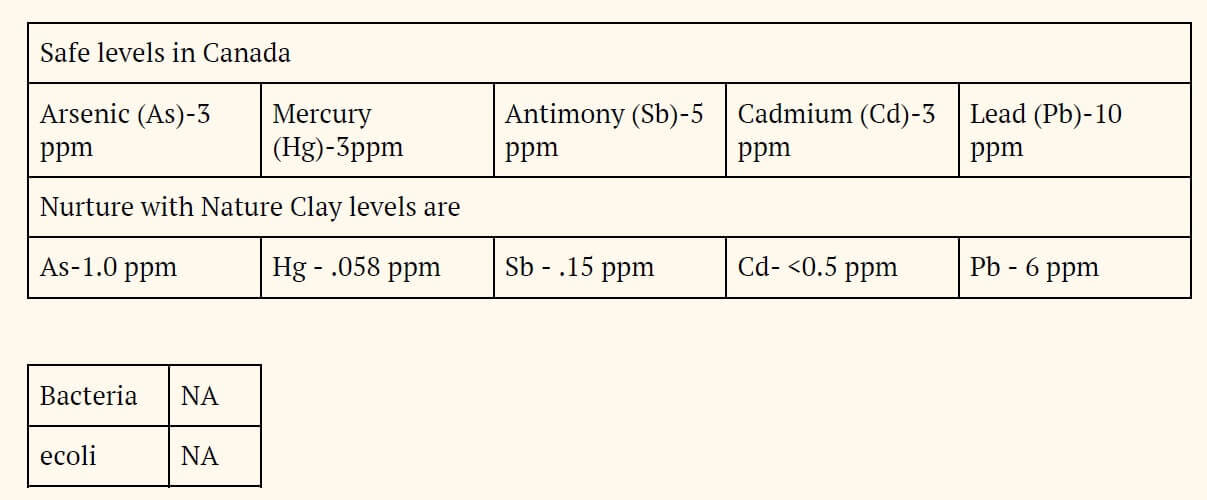Clay Benefits - Why It's a Rare Gift to Cherish?
Share
What is Clay?
Clay is a key ingredient in the material world we live in. First and foremost, it is essential to define what clay is and how it differs from mud, soil, and minerals.
Clay is intelligent earth. It is made up of nanocrystals. Crystals are capable of memory, re-organization and holding energy (Boularand M., Heal Beyond).
Clay is a soft, loose, earthy material containing particles with a grain size of less than 2 micrometers (μm) (That’s 2000 times smaller than a millimeter), this size fraction commonly contains discrete clay minerals (smectite, illite, kaolinite).
It takes several centuries for the clay to reach the surface and concentrate in those soil layers (up to 85% of clay). On its way up, the clay transforms and gets loaded with bioavailable minerals and vital energy.
It forms as a result of the weathering and erosion of rocks containing the mineral group feldspar (known as the ‘mother of clay’) over vast spans of time. Nourished by the roots of the trees, plants and grass, exposed to the natural sunlight and rainwater, the Research shows that the way that the minerals and trace elements are found within clay is in the exact balanced ratio that the body needs for perfect assimilation (Boularand M., Heal Beyond).
During weathering, the feldspar content is altered by hydrolysis (reaction with water) to form clay minerals such as kaolinites (the principal minerals in kaolin clays) and smectites (the principal minerals in bentonite clays).
How does clay mask work?
Regarding the chemical composition, the clay can be used as a moisturizer, inflammation reducer, antiseptic, astringent, and healer of pain.
The adsorptive and absorptive properties of clay minerals have historically been the driving force behind the traditional use of healing and therapeutic clays. Initially, negatively-charged interlayer sites of clays will absorb positively-charged substances to their extensive surface area.
Adsorption is the process of attraction, binding, and accumulation of molecules or particles to a solid surface in a condensed layer.
Absorption results when a substance diffuses or penetrates into a liquid or solid forming a transition zone or layer, often with a new composition, adjacent to the substrate.
The clay first adsorbs toxins (heavy metals, free radicals, pesticides), attracting them to its extensive surface area where they adhere like flies to sticky paper; then it absorbs the toxins, taking them in the way a sponge mops up a kitchen counter mess.
The high adsorption and absorption capacities, cation exchange capacity, as well as the extremely fine particle size of certain clays, e.g. kaolin group minerals are important reasons why these minerals are used to remove oils, secretions, toxins, and contaminants from the skin. By adsorbing and absorbing moisture and impurities from the skin, the clays also serve to cleanse and refresh the skin surface and to aid in the healing of topical blemishes.
While the physical adsorption of water and organic matter is the most common attribute of healing clays, the geochemical mechanisms controlling the antibacterial properties of clays have received significantly less attention.
It is well known that metallic ions, such as silver, copper, and zinc, have strong inhibitory and bactericidal effects on a broad spectrum of bacteria (Williams L. B., Haydel S. E., Pub Med).
What makes natural clays antibacterial?
All clay are not created equal. They are extraordinarily different.
Antibacterial clays in nature include a variety of clay mineral assemblages that are capable of killing certain human pathogens. A new discovery by Arizona State University scientists shows exactly how two specific metallic elements in the blue and green clays work in tandem to kill bacteria. Aluminum attacks the bacteria’s cell wall, creating an entryway for iron. Iron enters the cell through the newly opened holes, oxidizing the bacteria and slowing down its growth (Morrison K.D., et al., Nature).
Unique Blue Clay from Vancouver Island
The North Slope blue and green Clay is a unique, complex, hydrating clay found on the slopes of a dormant volcano located on the western edge of Vancouver Island.
The Clay sits at an elevation of 1000 feet above sea level on the north side of the mountain. It was created from a volcanic dike through millions of years of volcanic movement and its location being directly at the source, has meant it has not had the chance to be contaminated with toxic heavy metals.
These clays have been used by not just indigenous peoples for thousands of years, but evidence proves it has been used and mined by seafaring peoples from places beyond the continuant of America for thousands of years.
Indian Legend about a Valley of Healing Clay clearly shows this clay is very special.
The mighty Eagle Spirit found the great chieftain, wounded in a battle, picked him up with his mighty talons and carried him high above the rain forest to a far away hidden valley, which was the home of the healing clay.
The legends say that the valley was the protector of this magical substance that could cleanse and heal all wounds. Eagle Spirit gently laid the chieftain in a clay bed where his wounds healed, as if by magic.
The clay, as told by the Eagle Spirit, "is to be used for healing and purifying and is nature's gift to all".

Clay is loaded with vital energy from Mother Nature. Clay provides an impressive assortment of minerals, including calcium, iron, magnesium, potassium, sulfur, manganese, and silica as well as trace elements—those appearing in very tiny amounts.
4 healing gems make up 37 percent of this Clay structure; adding to its capacity for spiritual, physical, emotional & mental healing:
Prehnite... clarity heart & mind. It is detoxifying and supports the immune system, so is an optimal choice to fight infection. It also supports healing in most systems of the body, especially connective tissue, bones and skin.
Diopside ... heart connection to earth. It will restore the alkaline balance and will assist you if you have muscular aches and spasms.
Seraphinite…increase detox for chakra healings. It brings vitality and renewed energy.
Non-fibrous Actinolite...tuning us inside out; to all that is. It assists in reducing the negative effects that occur in the body due to over-stress.
Blue Clay Mineral Analysis

Governments have very strict regulations regarding 5 heavy metals. Blue Kaolin Clay analysis for these 5 elements is far below these levels. I believe because of being located so close to its source and being so old.
What are blue clay mask benefits?
The benefits of clay are wide-ranging and enrich our skins from the inside out! In their natural form they contain many minerals and rare earth elements. With a very high negative ion charge, clays have a powerful pulling action, which exfoliates and detoxifies. Blue Clay has an abundance of benefits and when infused into your self-care regime can provide a host of awesome results:
-
helps to detoxify skin and body of impurities (removes accumulated dead and dry skin cells, toxins and bacteria )
-
helps rejuvenate the look of youthful, healthy skin
-
enhances the cellular and immune function of the skin (re-mineralizes cells and tissues, alkalizes the body)
-
softens & protects the skin
-
stimulates circulation
-
helps to balance (neutralizes excess of sebum)
-
accelerates cell regeneration
-
soothes inflammation (especially from the joints, muscles, back, insect bites, itching, sunburns)
Lathering yourself in Blue Kaolin Clay and scrubbing it off with water will leave your skin feeling rejuvenated, soft, and radiant. Plus, it is so fun to put on! If you can do this in a hot bath, the steam will help with the penetration and it will work even better!
